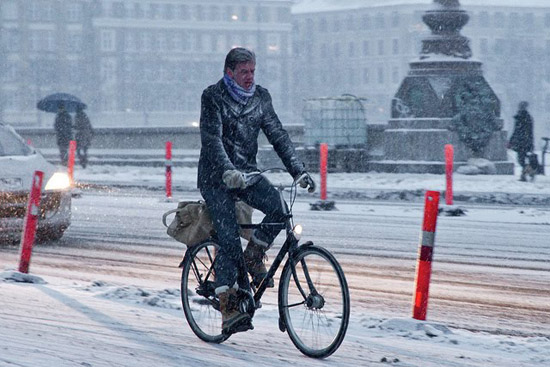On Two Wheels: Winter Cycling in Krakow, Part 1
Grey and drab Christmas is over, and how is your bicycle? There has been little reason to stop cycling this winter: no snow, spring-like temperatures and new cycle facilities in Krakow, including bike boxes. However, I was reminded to write about true winter cycling. On New Year’s Day, I cycled in the evening and, impressed by the fog (smog, rather), I stopped to take a picture. My foot slipped and I almost toppled. The fog had frozen on the ground and I hadn’t noticed while cycling. You often don’t realise how slippery it is until you stop and put your feet on the ground. Last year, I fell over in exactly this circumstance. It was the very first time I had fallen from a bike in more than twenty winters of cycling, including in the iciest and snowiest conditions imaginable.
So how do you cycle in winter? Is it even possible? Danish cycling advocate and planner Mikael Colville-Andersen (Copenhagenize.com) has coined the lovely phrase: Viking Biking. In Copenhagen, a Scandinavian city famed for its cycling crowds, bicycle traffic in the winter is still 80% of that in the summer. People just don’t stop cycling. And no, they do not dress up in arctic clothing. They just get on their bikes and ride on. It is entirely possible for an urbane Western population, so it must be possible in Krakow.
 Viking Biking in Copenhagen
Viking Biking in Copenhagen
The secret is gloves and a hat. Your hands get frozen first, and riding a bike in strong winds at minus twenty degrees Celsius can be really painful without gloves. I wear a pair of ordinary leather gloves. They are windproof, which is crucial. Canadians use ‘bar mitts’ or ‘pogies’ – hand covers attached to the handlebars. You put your gloved hands inside and can use the brakes and gears from there, well protected from the chill. A hat is obvious and, if you wear glasses, you will certainly appreciate a visor that protects you from sleet and snow. If you have ever wondered what the best kind of garment for winter cycling is, my choice is a regular, long coat. It keeps your thighs and rear warm and also protects you from ice that may have built up on the saddle.
Real winter will instantly rust your bicycle. The chain is exposed to the elements, including salt, and it sprinkles rust around. You have two options: either clean and grease the drivetrain every two or three days, or switch to a civilised planetary gear hub and a full chain cover (you may need a new frame for this, too). A few years ago, I discovered a smart German device called the Hebie Chainglider: four plastic parts that click onto the chain (no tools!) enclosing it completely. After two winters, with my bicycle often parked outdoors, there was no need to grease the chain. The catch is that it won’t work with derailleurs or even a chain tensioner, and you have to carefully select the cover size (you buy the front and rear parts separately).
You also need to take care of your bike lock, ice can easily freeze it solid, leaving you with a bike that’s going nowhere until the spring thaw. Spray it regularly with WD-40 or something similarly magical. If a glass of hot water does’t help, you may need to call the fire brigade to cut it off.


I put on a set of studded tires for winter. Gets me through ice and light snow with ease and no falling. Studded tires are availble in sizes for both mountain and road bikes.
Same here, we put studded tyres on our recumbents in winter so no slipping and sliding. And really really important to clean and lubricate your chain regularly to save expense of replacing drivetrain prematurely.